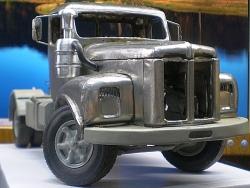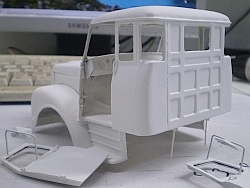Making miniature truck to bring a load of good recollections!
|
|
|
|
|
|
|
|
|
|
|
|
|
|
|
|
|
|
|
|
|
|
|
|
|
Making miniature truck to bring a load of good recollections! |
||||
|
|
|
|
Scania scale model - Assembly line Project B |
|
|
The Scania Season began! This Scania Scale Project must have over six different models of trucks from the 50s to the 80s. All made of stamped tin plate. Project totally redone. The scale is 1:25. |
|
|
Molded tinplate Scale Models Catalog Motor Grader Caterpillar 120B Scale Model |
|
SCALE MODEL ASSEMBLY LINE |
|
| Scania L111 | |
|
Scania L36 |
Scania L75 |
 |
|
|
The first chosen model The first cab that I assembled is the L111 sleeper-cab, one of the most known Scania models in the world. I adopted the Brazilian version that has a few differences from the European one. In this one that I made, the window in the rear corner of the cab is larger, to begin with. |

|
|
The Project |
|
I have been planning to make the Scania scale model for two years, but I scarcely have had time to do the common works. Now it is time to begin the Scania. I, humbly, intended to represent some of the models usually seen on the roads all over the world in the past 70 years. The old models are those that I am an enthusiast. I did not had access to the documentation concerning the models of brand and all that I have done about the old Scania models is based on the pictures that I have found in the internet. The angles and the curves are deceiving, specially seen on pictures. So, some details may not be as accurate as one should expect. Some are not as I expected too. This is the Scania Project “B”. In the Project “C” and son on, the improvements will be made. I had to make the moulds in steel. When one has none but scarce means, the only way to do this project is by the hard work. I am talking about actually sculpt all the moulds in steel.
The actual project comprehends some of the most known Scania trucks. The scale is 1:25 and the scale models that I intend to make are:
At least 36 cabs will be made.
Many questions have been made concerning this project. Some of them are: Why so many models at a time? Why duplicated? There are any reasons why the thing came to be this way. Reason 1: Since when I was working on the Brazilian FNM Truck Project (I called it FNM project A), about two years ago, the many fans of the Scania brand asked me for a Scania scale model. Only now I am taking the time to get things on the way. Reason 2: When I make one model, I try to make as many cabs as I can. In the so rushed day by day work with computers it is difficult to stop and make a scale model from zero. Reason 3: There are so many models because, sometimes, when I make only one type, people want other ones. Reason 4: There are duplicated models because even though the main idea is not to sell any model, indeed I sell them. Sometimes, none remains in my hands. People usually say: “Sell it to me. You can make another one for yourself at any time.” I want to have in my collection one sample of each model a make. Then I assume that some of the Scania scale models are to be sold. Reason 5: When researching some truck brand, a have a travel through its models releases and became very fond of each of them, specially the classic ones.
Molds I do not make prototypes out of clay because the way I am used to make them is somehow different from the way other people do. Instead, I prefer some types of car body filler. Anyway it is better to take a whole month to make the moulds than doing the work only by hammer. Later, if I have to make the same model, I do not have to take care about its measures or shapes. Get better quality, not to mention that the time to complete the model is significantly reduced. Quality here is something that must be explained. The models are craft work that must be good enough within their scope and should not be compared with the ones that come from an industrial assembly line.
Inside the cabs Sometimes we have to use the experience and a bit of imagination to compound the parts inside the cab because of the lack of access to the documentation. The similarity between models has a big impact on the result. There are times when the result is not what we wanted it to be, but there is not too much to be done. Documentation is gold when trying to replicate something. I used to write to the brands asking some data about their models, but in general they do not care about it. After I had an insane job to make a Mercedes-Benz Axor 2640, there is, now, plenty of documentation on the MB site. I suppose that every scale modeler could do a better work with the right data. But I have to admit that if my Scania models do not look like a Scania, that is my fault. Let us let the builder alone in this case.
The first chosen model The first cab that I assembled is the L111 sleeper-cab, one of the most known Scania in the world. I adopted the Brazilian version that has a few differences from the European one. The window in the rear corner of the Brazilian cab is larger, to begin with.
General considerations concerning the project
Because this project deals with craft work that implies handmade and detailed parts one by one, some preoccupations were constant: 1 - Reach a determined quality standard; 2 - Obtain well resistant parts; 3 - The material had to be metal in at least 80% of the parts; 4 - The parts had to be standardized and interchangeable; 5 - Reduce each part production time without changing the quality.
Not all the aims that were stated above could be reached here, but I hope that it can be done in the next version of the project.
More information may be added to this article at any time. |
| There is more on this to show and will be added as soon as possible. |
|
Ivan Gouveia
Post graduate in Computer Networking from FACIMED - Faculty of Biomedical Sciences of Cacoal. Graduate in Information Technology from UNESC - Union of Colleges of Cacoal. Has a CCNA (Cisco) as complementary course on Computer Networks. Is professional in the field of Electronics and Computer Programming. Programmer in languages Delphi and Visual Basic. |